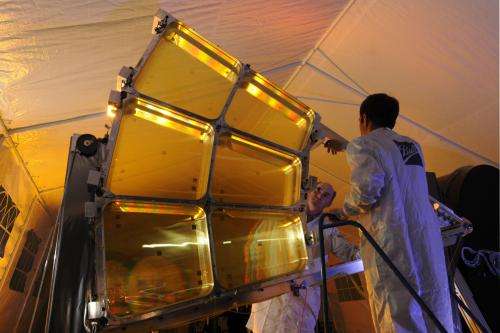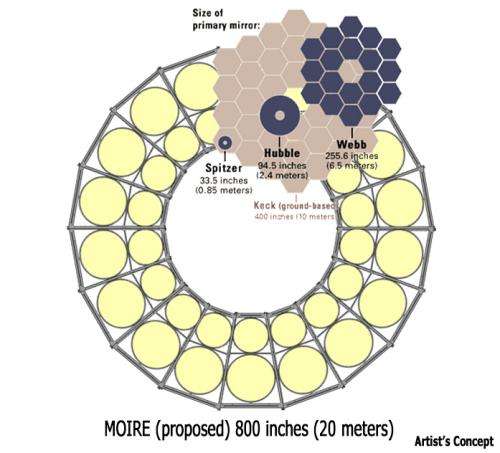First folding space telescope

The capability of orbital telescopes to see wide swaths of the earth at a time has made them indispensable for key national security responsibilities such as weather forecasting, reconnaissance and disaster response. Even as telescope design has advanced, however, one aspect has remained constant since Galileo: using glass for lenses and mirrors, also known as optics. High-resolution imagery traditionally has required large-diameter glass mirrors, which are thick, heavy, difficult to make and expensive. As the need for higher-resolution orbital imagery expands, glass mirrors are fast approaching the point where they will be too large, heavy and costly for even the largest of today's rockets to carry to orbit.
seeks to address these challenges. MOIRE aims to create technologies that would enable future high-resolution orbital telescopes to provide real-time video and images of the Earth from Geosynchronous Earth Orbit (GEO)—roughly 22,000 miles above the planet's surface. Size and cost constraints have so far prevented placing large-scale imaging satellites in GEO, so MOIRE is developing technologies that would make orbital telescopes much lighter, more transportable and more cost-effective.
Currently in its second and final phase, the program recently successfully demonstrated a ground-based prototype that incorporated several critical technologies, including new lightweight polymer membrane optics to replace glass mirrors. Membrane optics traditionally have been too inefficient to use in telescope optics. MOIRE has achieved a technological first for membrane optics by nearly doubling their efficiency, from 30 percent to 55 percent. The improved efficiency enabled MOIRE to take the first images ever with membrane optics.
While the membrane is less efficient than glass, which is nearly 90 percent efficient, its much lighter weight enables creating larger lenses that more than make up the difference. The membrane is also substantially lighter than glass. Based on the performance of the prototype, a new system incorporating MOIRE optics would come in at roughly one-seventh the weight of a traditional system of the same resolution and mass. As a proof of concept, the MOIRE prototype validates membrane optics as a viable technology for orbital telescopes.
"Membrane optics could enable us to fit much larger, higher-resolution telescopes in smaller and lighter packages," said Lt. Col. Larry Gunn, DARPA program manager. "In that respect, we're 'breaking the glass ceiling' that traditional materials impose on optics design. We're hoping our research could also help greatly reduce overall costs and enable more timely deployment using smaller, less expensive launch vehicles."
Instead of reflecting light with mirrors or refracting it with lenses, MOIRE's membrane optics diffract light. Roughly the thickness of household plastic wrap, each membrane serves as a Fresnel lens—it is etched with circular concentric grooves like microscopically thin tree rings, with the grooves hundreds of microns across at the center down to only 4 microns at the outside edge. The diffractive pattern focuses light on a sensor that the satellite translates into an image.

MOIRE technology houses the membranes in thin metal "petals" that would launch in a tightly packed configuration roughly 20 feet in diameter. Upon reaching its destination orbit, a satellite would then unfold the petals to create the full-size multi-lens optics. The envisioned diameter of 20 meters (about 68 feet) would be the largest telescope optics ever made and dwarf the glass mirrors contained in the world's most famous telescopes.
From GEO, it is believed, a satellite using MOIRE optics could see approximately 40 percent of the earth's surface at once. The satellite would be able to focus on a 10 km-by-10 km area at 1-meter resolution, and provide real-time video at 1 frame per second.
Provided by DARPA

















